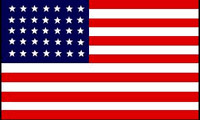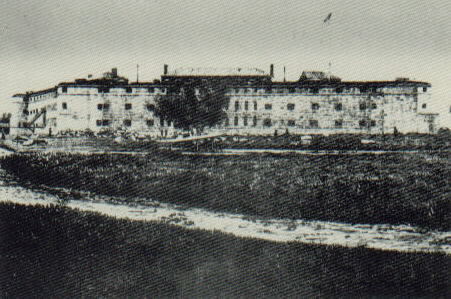Johnson's Island Prisoner of War Camp
Search, View, Print Union & Confederate Civil War Prisoner of War Records, 1861-1865

Union 1861-1865
Philadelphia, Pennsylvania
Fort Delaware is situated on Pea Patch Island in the Delaware River, 1 mile east of Delaware City. The island was named after a Colonial-era legend that a boat loaded with peas ran aground on a river shoal, and then the peas sprouted in the sandy loam.
Work on the present fort began in 1848. The cost of driving foundation pilings depleted the congressional funds, so an additional $1 million was approved to continue the work. Construction of the fort began in 1849, and major construction was completed in 1859, just 2 years before the Civil War. The Pentagon-shaped structure covers about 6 acres of the 70 - 19th century acres considered fast land. The parade ground, originally more than 2 acres, was reduced in 1896 when concrete emplacements for 3 12-inch disappearing guns were built in the southern half of the enclosure. The entire east barracks and a portion of the west barracks were removed at that time. The 32 foot high walls are of solid granite blocks and bricks and vary in thickness from seven feet to 30 feet. The fort is surrounded by a 30-foot wide moat, crossed by a drawbridge on the southwest side leading to the sally port, or principal entrance.
There were 3 tiers for guns, 2 consisting of rows of casemates containing examples of what was once described as some of the finest brick masonry work in the country. More than 25 million bricks were used to construct the fort and the interior buildings. The circular granite stairways are unique architectural features. Two barracks buildings now face the parade ground. The commanding general's office and living quarters for officers were in the building on the north side. Enlisted men's quarters, mess halls, and kitchens were located in the west side buidling.
The fort was first occupied by 1 company of regular artillery in February 1861. The Commonwealth Artillery of Pennsylvania was the first volunteer unit to move in after the Civil War began.
After the Battle of Kernstown in 1862, 250 troops of Stonewall Jackson's army - mostly Virginians - became the island's first large group of Confederate prisoners of war. Fort Delaware had not been constructed for such use, and the barracks space was overcrowded with prisoners. Consequently, wooden barracks were erected outside the fort in 1862 to house 2,000 prisoners. By June 1863, there were 6,000 prisoners on the island, and the prison compound had been expanded to house 10,000 men.
Most of the Confederates captured at Gettysburg, from General James J. Archer down to the last private, were imprisoned at Fort Delaware after the battle, and by August 1863 there were 12,500 prisoners on the island. Among the 3,000 or so total political prisoners housed at the fort were Burton H. Harrison, private secretary to Jefferson Davis, and Governor E R. Lubbock of Texas, who was the last prisoner at the fort in 1866.
 |
A total of 2,927 Confederate military prisoners, 39 civilian detainees, and 109 Union guards known to have died while at the fort. The names of 2,436 Confederate military prisoners and civilian detainees are presented on the bronze memorial plaques that surround the base of the 1912 Confederate memorial in Finns Point National Cemetery. The Union monument at Finns Point, erected in 1879, lists 105 names of Union guards and states that 30 others could not be identified.
Early in the war, burials of Confederate prisoners and Union guards were made in nearby Delaware church yards and apparently a few on Pea Patch Island itself. Beginning as early as May 1863, the Finns Point soldier's burial ground, first used during the pre-war construction of Fort Delaware and located across the Delaware River in Salem County, New Jersey, was pressed into service. With only a few known exceptions, the Confederate remains buried in Delaware and the few Confederate and Union remains buried on Pea Patch Island were removed and taken to Finns Point in the 1870s. Finns Point, located adjacent to Fort Mott State Park in New Jersey, was designated a National Cemetery in 1875.
